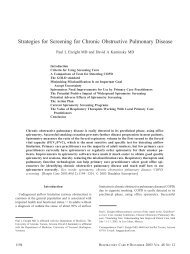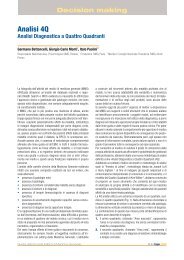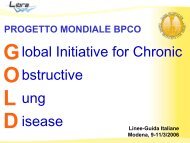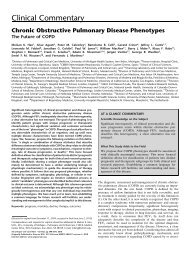Aging with multimorbidity: A systematic review of the literature - GOLD
Aging with multimorbidity: A systematic review of the literature - GOLD
Aging with multimorbidity: A systematic review of the literature - GOLD
You also want an ePaper? Increase the reach of your titles
YUMPU automatically turns print PDFs into web optimized ePapers that Google loves.
Ageing Research Reviews 10 (2011) 430–439<br />
Contents lists available at ScienceDirect<br />
Ageing Research Reviews<br />
jo u r n al hom epage: www.elsevier.com/locate/arr<br />
Review<br />
<strong>Aging</strong> <strong>with</strong> <strong>multimorbidity</strong>: A <strong>systematic</strong> <strong>review</strong> <strong>of</strong> <strong>the</strong> <strong>literature</strong><br />
Alessandra Marengoni a,b,∗ , Sara Angleman a , René Melis a,c , Francesca Mangialasche a,d ,<br />
Anita Karp a,e , Annika Garmen a,e , Bettina Meinow a,e , Laura Fratiglioni a,e<br />
a <strong>Aging</strong> Research Center, NVS Department, Karolinska Institutet and Stockholm University, Sweden<br />
b Geriatric Unit, Department <strong>of</strong> Medical and Surgery Sciences, University <strong>of</strong> Brescia, Italy<br />
c Nijmegen Alzheimer Centre, Radboud University Nijmegen Medical Centre, Nijmegen, The Ne<strong>the</strong>rlands<br />
d Institute <strong>of</strong> Gerontology and Geriatrics, Department <strong>of</strong> Clinical and Experimental Medicine, University <strong>of</strong> Perugia, Italy<br />
e Stockholm Gerontology Research Center, Stockholm, Sweden<br />
a r t i c l e i n f o<br />
Article history:<br />
Received 30 January 2011<br />
Received in revised form 3 March 2011<br />
Accepted 7 March 2011<br />
Available online 12 March 2011<br />
Keywords:<br />
<strong>Aging</strong><br />
Chronic diseases<br />
Multimorbidity<br />
Prevalence<br />
Incidence<br />
Risk factors<br />
Consequences<br />
Quality <strong>of</strong> care<br />
a b s t r a c t<br />
A <strong>literature</strong> search was carried out to summarize <strong>the</strong> existing scientific evidence concerning occurrence,<br />
causes, and consequences <strong>of</strong> <strong>multimorbidity</strong> (<strong>the</strong> coexistence <strong>of</strong> multiple chronic diseases) in <strong>the</strong> elderly<br />
as well as models and quality <strong>of</strong> care <strong>of</strong> persons <strong>with</strong> <strong>multimorbidity</strong>. According to pre-established<br />
inclusion criteria, and using different search strategies, 41 articles were included (four <strong>of</strong> <strong>the</strong>se were<br />
methodological papers only). Prevalence <strong>of</strong> <strong>multimorbidity</strong> in older persons ranges from 55 to 98%. In<br />
cross-sectional studies, older age, female gender, and low socioeconomic status are factors associated<br />
<strong>with</strong> <strong>multimorbidity</strong>, confirmed by longitudinal studies as well. Major consequences <strong>of</strong> <strong>multimorbidity</strong><br />
are disability and functional decline, poor quality <strong>of</strong> life, and high health care costs. Controversial results<br />
were found on <strong>multimorbidity</strong> and mortality risk. Methodological issues in evaluating <strong>multimorbidity</strong><br />
are discussed as well as future research needs, especially concerning etiological factors, combinations and<br />
clustering <strong>of</strong> chronic diseases, and care models for persons affected by multiple disorders. New insights<br />
in this field can lead to <strong>the</strong> identification <strong>of</strong> preventive strategies and better treatment <strong>of</strong> multimorbid<br />
patients.<br />
© 2011 Elsevier B.V. All rights reserved.<br />
1. Introduction<br />
Thousands <strong>of</strong> persons turn 65 years <strong>of</strong> age every day (Cohen,<br />
2003; Kinsella and Velk<strong>of</strong>f, 2005). Life expectancy has already<br />
exceeded age 75 in 57 countries (World Health Organization, WHO,<br />
2010), and it is expected to continue to rise (Oeppen and Vaupel,<br />
2002). In <strong>the</strong> world, <strong>the</strong> proportion <strong>of</strong> 60+ year-old people has<br />
gradually increased from 8.1% in 1960 to 10% in 2000. Despite<br />
<strong>the</strong> worldwide aging phenomenon, data regarding health and time<br />
trends in <strong>the</strong> health <strong>of</strong> <strong>the</strong> elderly are still inadequate. What is certain<br />
is that over <strong>the</strong> last century, chronic health problems have<br />
replaced infectious diseases as <strong>the</strong> dominant health care burden,<br />
and almost all chronic conditions are strongly related to aging. Only<br />
in <strong>the</strong> last few years many health care planners and governments<br />
have becoming aware <strong>of</strong> this phenomenon and population-based<br />
studies regarding age-related chronic diseases have been implemented.<br />
∗ Corresponding author at: Department <strong>of</strong> Medical and Surgery Sciences, University<br />
<strong>of</strong> Brescia, Division <strong>of</strong> Internal Medicine I, Spedali Civili, Piazzale Spedali Civili<br />
1, 25123 Brescia, Italy. Tel.: +39 030 2528554; fax: +39 030 396011.<br />
E-mail addresses: marengon@med.unibs.it, alessandra.marengoni@ki.se<br />
(A. Marengoni).<br />
The majority <strong>of</strong> <strong>the</strong> available studies have focused on specific<br />
illnesses or on <strong>the</strong> coexistence <strong>of</strong> a relatively small number <strong>of</strong> diseases,<br />
such as cardiovascular diseases, diabetes, and cancer, ra<strong>the</strong>r<br />
than on <strong>the</strong> whole range <strong>of</strong> chronic morbidity affecting older persons.<br />
Few studies have investigated how diseases distribute or<br />
co-occur in <strong>the</strong> same individual, and most <strong>of</strong> <strong>the</strong>m have used different<br />
approaches to address this issue (Gijsen et al., 2001). Two<br />
terms “comorbidity” and “<strong>multimorbidity</strong>” have been mostly used<br />
(Yancik et al., 2007). The term comorbidity was introduced 1970<br />
and refers to <strong>the</strong> combination <strong>of</strong> additional diseases beyond an<br />
index disorder (Feinstein, 1970). This definition implies that <strong>the</strong><br />
main interest is on an index condition and <strong>the</strong> possible effects <strong>of</strong><br />
o<strong>the</strong>r disorders on <strong>the</strong> prognosis <strong>of</strong> this disease. In contrast, <strong>multimorbidity</strong><br />
is defined as any co-occurrence <strong>of</strong> diseases in <strong>the</strong> same<br />
person indicating a shift <strong>of</strong> interest from a given index condition to<br />
individuals who suffer from multiple diseases (Batstra et al., 2002).<br />
Different operational definitions <strong>of</strong> chronic <strong>multimorbidity</strong> are<br />
detectable in <strong>the</strong> <strong>literature</strong>. Indeed, <strong>multimorbidity</strong> has been<br />
addressed from three major perspectives which have led to three<br />
major operational definitions:<br />
1. Number (commonly two or three) <strong>of</strong> concurrent diseases in <strong>the</strong> same<br />
individual. This definition, which has been used mostly in epi-<br />
1568-1637/$ – see front matter © 2011 Elsevier B.V. All rights reserved.<br />
doi:10.1016/j.arr.2011.03.003
A. Marengoni et al. / Ageing Research Reviews 10 (2011) 430–439 431<br />
demiological studies, includes both individuals who may live<br />
relatively unaffected by <strong>multimorbidity</strong> <strong>with</strong> <strong>the</strong> help <strong>of</strong> medications<br />
and those who face severe functional loss.<br />
2. Cumulative indices evaluating both number and severity <strong>of</strong> <strong>the</strong> concurrent<br />
diseases. This definition is very suitable in clinical studies<br />
where <strong>the</strong> major aim is to identify persons at risk for negative<br />
health outcomes and might benefit from specific interventions.<br />
Most used indices are: <strong>the</strong> Charlson Comorbidity Index (Charlson<br />
et al., 1987), <strong>the</strong> Index <strong>of</strong> Co-Existent Diseases (ICED) (Greenfield<br />
et al., 1993), and <strong>the</strong> Cumulative Illness Rating Scale (CIRS) (Linn<br />
et al., 1968).<br />
3. The simultaneous presence <strong>of</strong> diseases/symptoms, cognitive and<br />
physical functional limitations. In order to estimates trends <strong>of</strong><br />
prevalence rates <strong>of</strong> elderly people <strong>with</strong> complex health problems<br />
that imply care needs involving several providers <strong>of</strong> both<br />
medical care and social services, studies address <strong>multimorbidity</strong><br />
taking into account not only <strong>the</strong> cumulative effect <strong>of</strong> concurrent<br />
diseases, but also relevant factors such as symptoms, cognitive<br />
and physical dysfunctions, and psychosocial problems.<br />
Given <strong>the</strong> complexity and heterogeneity <strong>of</strong> <strong>the</strong> health status<br />
<strong>of</strong> <strong>the</strong> elderly and <strong>the</strong> age-related pathologies, no single<br />
operational criteria will serve all research and clinical purposes<br />
effectively (Valderas et al., 2009; Fratiglioni et al., 2010). However,<br />
<strong>the</strong> common denominator <strong>of</strong> all <strong>the</strong> definitions is given by<br />
concurrence <strong>of</strong> several chronic diseases whose severity can be<br />
graded or not <strong>with</strong> different methods. For that reason, in this<br />
<strong>review</strong>, we will focus only on chronic <strong>multimorbidity</strong> based on<br />
clinical diagnoses and defined as <strong>the</strong> co-occurrence <strong>of</strong> multiple<br />
diseases in <strong>the</strong> same individual. Specific aims <strong>of</strong> this study are to<br />
summarise <strong>the</strong> scientific evidence cumulated in <strong>the</strong> last 20 years<br />
concerning occurrence, causes and consequences <strong>of</strong> <strong>multimorbidity</strong><br />
in older persons and to compare <strong>the</strong> most relevant studies<br />
concerning models and quality <strong>of</strong> care for persons <strong>with</strong> <strong>multimorbidity</strong>.<br />
2. Methods<br />
We used MEDLINE/Pubmed database from January <strong>the</strong> 1st<br />
1990 through November <strong>the</strong> 1st 2010 to identify <strong>the</strong> relevant<br />
studies. Criteria for inclusion were: original articles, English language,<br />
human subjects, and <strong>the</strong> availability <strong>of</strong> an abstract in<br />
Pubmed. We used two search strategies. First, <strong>the</strong> keywords<br />
‘<strong>multimorbidity</strong>’, ‘multi-morbidity’, ‘<strong>multimorbidity</strong> AND comorbidity’,<br />
‘multi-morbidity AND comorbidity’, ‘<strong>multimorbidity</strong> AND<br />
co-morbidity’ were included as search criterion in all fields. Second,<br />
<strong>the</strong> terms ‘multiple AND diseases’ and ‘multiple AND conditions’<br />
were used but sought in <strong>the</strong> title only.<br />
Of <strong>the</strong> 302 articles identified <strong>with</strong> <strong>the</strong> first search strategy,<br />
145 overlapped (i.e., <strong>the</strong> same articles were identified using different<br />
search terms). The abstracts <strong>of</strong> <strong>the</strong> remaining 157 articles<br />
were screened by two co-authors (A.M., S.A.) and 113 reports<br />
were excluded due to <strong>the</strong> following reasons: age < 65 years for <strong>the</strong><br />
complete study population; evaluation <strong>of</strong> specific comorbidities,<br />
instead <strong>of</strong> overall <strong>multimorbidity</strong>; selection <strong>of</strong> specific subgroups,<br />
such as drug users or patients <strong>with</strong> psychiatric conditions, or<br />
specific index diseases such as diabetic persons; evaluation <strong>of</strong><br />
very low sample size (
432 A. Marengoni et al. / Ageing Research Reviews 10 (2011) 430–439<br />
Table 1<br />
Description <strong>of</strong> <strong>the</strong> selected cross-sectional studies concerning <strong>multimorbidity</strong>: prevalence and associated factors.<br />
Reference<br />
Setting<br />
Participants<br />
Ascertainment and definition <strong>of</strong><br />
<strong>multimorbidity</strong><br />
Results<br />
Prevalence and associated factors<br />
van den Akker et al. (1998) Dutch general population<br />
N = 60,857 (all ages)<br />
Wolff et al. (2002) US Medicare fee-for-service<br />
N = 1,217,103 (65+ years)<br />
John et al. (2003) American Indian rural community<br />
residents<br />
N = 1039 (60+ years)<br />
Sharkey (2003) US homebound women<br />
N = 279 (60+ years)<br />
Fortin et al. (2005) Canada residential<br />
N = 980 (18+ years)<br />
Walker (2007) Australian general population<br />
N = 17,450 (20+ years)<br />
Schram et al. (2008) Dutch general population,<br />
institutionalized and hospitalized<br />
people<br />
N = 2693/599/2895/5610/1.058.234<br />
(55+ years)<br />
Marengoni et al. (2008) Swedish living in community and<br />
institutions<br />
N = 1099 (78+ years)<br />
Uijen and van de Lisdonk (2008) Dutch general population<br />
N = 13584 (all ages)<br />
Britt et al. (2008) Australian general practitioner patients<br />
N = 9156 (all ages)<br />
Schneider et al. (2009) US Medicare recipients (institutional<br />
and not)<br />
N = 2,232,528 (all ages)<br />
Loza et al. (2009) Spanish living in community<br />
N = 2192 (20+ years)<br />
General practitioners records<br />
Multimorbidity defined as 2+<br />
co-existing chronic diseases<br />
Administrative database<br />
Multimorbidity defined as 2+<br />
co-existing chronic diseases<br />
Self-report<br />
Multimorbidity defined as 2+<br />
co-existing chronic diseases<br />
Self-report<br />
Multimorbidity defined as number <strong>of</strong><br />
chronic diseases<br />
General practitioner records<br />
Multimorbidity defined as 2+<br />
co-existing chronic diseases<br />
Self-report<br />
Multimorbidity defined as 3+<br />
co-existing diseases<br />
Self-report, clinical examination,<br />
general practitioner records<br />
Multimorbidity defined as 2+<br />
co-existing chronic diseases<br />
Medical examination, blood samples,<br />
inpatient register<br />
Multimorbidity defined as 2+<br />
co-existing chronic diseases<br />
General practitioners records<br />
Multimorbidity defined as increasing<br />
number <strong>of</strong> diseases; prevalence refers<br />
to people <strong>with</strong> 4+ co-occurring<br />
conditions<br />
General practitioners records and<br />
self-report<br />
Multimorbidity defined as 2+<br />
co-existing chronic diseases<br />
Chronic condition data warehouse<br />
Multimorbidity defined as 2+<br />
co-existing chronic diseases<br />
Self-report<br />
Chronic diseases<br />
Multimorbidity defined as 2+<br />
co-existing chronic diseases<br />
74% in men and 80% in women aged<br />
80+ years<br />
Female gender, older age, lower<br />
education, public health insurance and<br />
living in a home for elderly<br />
65%<br />
73.8%<br />
Food insufficiency was associated <strong>with</strong><br />
having 3+ diseases<br />
98% in 65+ years<br />
85% in 70+ years<br />
Older age, obesity, female gender, low<br />
socioeconomic status and living alone<br />
82% in nursing homes, 56–72% in <strong>the</strong><br />
general population and GP registers,<br />
and 22% in hospital setting<br />
55%<br />
Older age, female gender, lower<br />
education<br />
30% in 65–74; 55% in 75+ years<br />
Older age, female gender, low<br />
socio-economic class<br />
83% in 75+<br />
20.3%<br />
30%<br />
Britt et al. 2008<br />
van den Akker et al.<br />
1998<br />
John et al. 2003<br />
Wolff et al. 2002<br />
Marengoni et al.<br />
2008<br />
0 20 40 60 80 100<br />
%<br />
75+ yrs<br />
80+ yrs<br />
60+ yrs<br />
65+ yrs<br />
78+ yrs<br />
Fig. 2. Variability in prevalence <strong>of</strong> <strong>multimorbidity</strong> (defined as 2+ co-existing chronic<br />
diseases) in <strong>the</strong> population across different studies (only 60+ year-old population<br />
are included).<br />
3.2. Studies on incidence and risk factors for <strong>multimorbidity</strong><br />
Four articles examined incidence and risk factors for <strong>multimorbidity</strong><br />
(Table 2); three <strong>of</strong> <strong>the</strong>m were embedded in <strong>the</strong> same<br />
population-based study from The Ne<strong>the</strong>rlands (van den Akker et al.,<br />
1998, 2000, 2001b) and one was carried out in Germany (Nagel<br />
et al., 2008). Disease ascertainment in <strong>the</strong>se studies was based<br />
on general practitioners’ records. Only one study reported 1-year<br />
incidence <strong>of</strong> <strong>multimorbidity</strong> (defined as 2 or more new diseases)<br />
which was 1.3% in <strong>the</strong> whole population (van den Akker et al.,<br />
1998). Identified risk factors for <strong>multimorbidity</strong> were: increasing<br />
age, higher number <strong>of</strong> previous diseases, and lower education,<br />
whereas a large social network seemed to play a protective role.<br />
No studies evaluating genetic background, biological causes, life<br />
styles, or environmental factors as risk factors for <strong>multimorbidity</strong><br />
were found.<br />
3.3. Studies on consequences <strong>of</strong> <strong>multimorbidity</strong><br />
<strong>the</strong> prevalence <strong>of</strong> <strong>the</strong> most common diseases <strong>of</strong> <strong>the</strong> elderly such as<br />
heart failure and dementia (Marengoni et al., 2008). Consistently<br />
across studies, older persons, women, and persons from low social<br />
classes were more likely to be affected by <strong>multimorbidity</strong>.<br />
The majority <strong>of</strong> <strong>the</strong> identified articles (n = 22) addressed <strong>the</strong><br />
consequences <strong>of</strong> <strong>multimorbidity</strong> (some <strong>of</strong> <strong>the</strong>m evaluated more<br />
than one outcome simultaneously) (Tables 3a–3d). In particular,<br />
five articles examined disability or functional performance
A. Marengoni et al. / Ageing Research Reviews 10 (2011) 430–439 433<br />
Table 2<br />
Characteristics <strong>of</strong> <strong>the</strong> selected studies concerning incidence and risk factors <strong>of</strong> <strong>multimorbidity</strong>.<br />
Author, year <strong>of</strong> publication Setting<br />
Participants<br />
van den Akker et al. (1998) South Ne<strong>the</strong>rlands<br />
Community residents<br />
N = 60,857 (all ages)<br />
van den Akker et al. (2000) South Ne<strong>the</strong>rlands<br />
Community residents<br />
N = 3745 (20+ years)<br />
van den Akker et al. (2001) South Ne<strong>the</strong>rlands<br />
Community residents<br />
N = 3551 (all ages)<br />
Nagel et al. (2008) Heidelberg, Germany<br />
Community residents<br />
N = 13,781 (50–75 years)<br />
Study design/ascertainment <strong>of</strong><br />
diseases<br />
Longitudinal<br />
General practitioners records<br />
Nested case–control study<br />
General practitioners records<br />
Longitudinal<br />
General practitioners records<br />
Longitudinal<br />
Self-report<br />
Results<br />
Incidence and risk factors<br />
1-year incidence: 5.6% in men and 6.1% in women in 80+ years<br />
Risk factors: older age, public health insurance and previous<br />
<strong>multimorbidity</strong><br />
Risk factors: increasing age, higher no. <strong>of</strong> previous diseases,<br />
and low socioeconomic status<br />
Protective factors: a high internal locus <strong>of</strong> control belief, living<br />
<strong>with</strong> someone and large social network<br />
Risk factors: low education (BMI was an intermediate factors<br />
in <strong>the</strong> association)<br />
Table 3a<br />
Description <strong>of</strong> <strong>the</strong> selected studies on consequences <strong>of</strong> <strong>multimorbidity</strong>: disability and functional decline.<br />
Author, year <strong>of</strong> publication Setting<br />
Participants<br />
Bayliss et al. (2004) US<br />
N = 1574 (57.6, SD = 15.4)<br />
Kadam et al. (2007) Community dwellers in UK<br />
N = 9439 (50+ years)<br />
Hudon et al. (2008) Residential households in Quebec,<br />
Canada<br />
N = 16782 (18–69 years)<br />
Marengoni et al. (2009) Swedish living in community and<br />
institutions<br />
N = 1099 (78+ years)<br />
Loza et al. (2009) Spanish living in community<br />
N = 2192 (20+ years)<br />
Study design/ascertainment <strong>of</strong><br />
diseases<br />
Longitudinal<br />
Medical records<br />
Cross-sectional<br />
General practice consultations<br />
Cross-sectional<br />
Interview and self-report<br />
Longitudinal<br />
Diagnoses from clinical<br />
examination, lab data, drugs and<br />
medical records.<br />
Cross-sectional<br />
Questionnaires<br />
Results<br />
Having 4+ chronic diseases was associated <strong>with</strong> 4-year decline<br />
in <strong>the</strong> physical component summary score SF-36<br />
Compared to those <strong>with</strong> one disease, having 2–3, 4–5, or 6+<br />
diseases was associated <strong>with</strong> poorer physical function<br />
measured <strong>with</strong> <strong>the</strong> SF-12<br />
Multimorbidity was not associated <strong>with</strong> physical activity levels<br />
Increasing number <strong>of</strong> chronic conditions increased <strong>the</strong> risk <strong>of</strong><br />
3-year functional decline<br />
Multimorbidity was associated <strong>with</strong> impaired functioning<br />
Table 3b<br />
Description <strong>of</strong> <strong>the</strong> selected studies on consequences <strong>of</strong> <strong>multimorbidity</strong>: mortality.<br />
Author, year <strong>of</strong> publication Setting<br />
Participants<br />
Menotti et al. (2001) Men rural community in Finland,<br />
Italy, and <strong>the</strong> Ne<strong>the</strong>rlands<br />
N = 2285 (65–84 years)<br />
Deeg et al. (2002) Community-dwelling in <strong>the</strong><br />
Ne<strong>the</strong>rlands<br />
N = 2141 (65–85 years)<br />
Byles et al. (2005) Australian veterans and war<br />
widows<br />
N = 1541 (70+ years)<br />
Marengoni et al. (2009) Swedish living in community and<br />
institutions<br />
N = 1099 (78+ years)<br />
Landi et al. (2010) Italians living in community<br />
N = 364 (80+ years)<br />
Ascertainment <strong>of</strong> diseases Results<br />
Clinical examination and<br />
self-report<br />
Having 2 or 3+ diseases significantly increased <strong>the</strong> 10-year<br />
mortality risk in all cohorts<br />
Self-report Having a <strong>multimorbidity</strong> pr<strong>of</strong>ile was associated <strong>with</strong><br />
3-year mortality<br />
Self-administered questionnaire Having 7+ diseases increased <strong>the</strong> risk <strong>of</strong> 2-year mortality<br />
Diagnoses from clinical<br />
3-year risk <strong>of</strong> death was <strong>the</strong> same for people <strong>with</strong> one<br />
examination, lab data, drugs and disease as well as 4+ diseases<br />
medical records<br />
Self report and medical records Multimorbidity affected 4-year mortality, only if<br />
associated <strong>with</strong> disability<br />
(Bayliss et al., 2004; Kadam et al., 2007; Hudon et al., 2008;<br />
Marengoni et al., 2009b; Loza et al., 2009; Table 3a); five studies<br />
examined <strong>the</strong> risk <strong>of</strong> death (Menotti et al., 2001; Deeg et al.,<br />
2002; Byles et al., 2005; Marengoni et al., 2009b; Landi et al.,<br />
2010; Table 3b); seven focused on quality <strong>of</strong> life or well-being<br />
(Byles et al., 2005; Fortin et al., 2006a,b; Walker, 2007; Min et al.,<br />
2007; Wong et al., 2008; Loza et al., 2009; Table 3c); and eight<br />
examined health care utilization and costs (Wolff et al., 2002;<br />
Noël et al., 2005, 2007; Byles et al., 2005; Friedman et al., 2006;<br />
Laux et al., 2008; Condelius et al., 2008; Schneider et al., 2009;<br />
Table 3d). With few exceptions, all studies found a significant<br />
effect <strong>of</strong> <strong>multimorbidity</strong> on disability, poor quality <strong>of</strong> life and high<br />
health care utilization and costs, even after adjustment for multiple<br />
confounders.<br />
3.3.1. Studies on functional status<br />
Among articles evaluating <strong>the</strong> association <strong>of</strong> <strong>multimorbidity</strong><br />
<strong>with</strong> disability or functional performances (Table 3a), two were<br />
longitudinal <strong>with</strong> a follow-up time <strong>of</strong> 3–4 years (Bayliss et al.,<br />
2004; Marengoni et al., 2009b) and three used a cross-sectional<br />
study design (Kadam et al., 2007; Hudon et al., 2008; Loza et al.,<br />
2009). The ascertainment <strong>of</strong> diseases was made by medical records<br />
in two studies (Bayliss et al., 2004; Kadam et al., 2007), by selfreport<br />
in two studies (Hudon et al., 2008; Loza et al., 2009), and by<br />
multiple information including clinical examination in one study<br />
(Marengoni et al., 2009b). An increasing number <strong>of</strong> diseases were<br />
consistently associated <strong>with</strong> increasing odds or risk for disability.<br />
Only one study (Hudon et al., 2008) showed no association between<br />
<strong>multimorbidity</strong> and physical functioning.
434 A. Marengoni et al. / Ageing Research Reviews 10 (2011) 430–439<br />
Table 3c<br />
Description <strong>of</strong> <strong>the</strong> selected studies on consequences <strong>of</strong> <strong>multimorbidity</strong>: quality <strong>of</strong> life.<br />
Author, year <strong>of</strong> publication Setting<br />
Participants<br />
Byles et al. (2005) Australian veterans and war<br />
widows<br />
N = 1541 (70+ years)<br />
Fortin et al. (2006a) Residential in Canada<br />
N = 238 (56.5, SD = 17.4)<br />
Fortin et al. (2006b) Residential in Canada<br />
N = 238 (56.5, SD = 17.4)<br />
Walker (2007) Australian general population<br />
N = 17,450 (20+ years)<br />
Wong et al. (2008) Residential volunteers in Hong<br />
Kong<br />
N = 3394 (65+ years)<br />
Loza et al. (2009) Spanish living in community<br />
N = 2192 (20+ years)<br />
Study design and ascertainment <strong>of</strong><br />
diseases<br />
Longitudinal<br />
Self-administered questionnaire<br />
Cross-sectional<br />
General practitioners records<br />
Cross-sectional<br />
General practitioners records<br />
Cross-sectional<br />
Self-report<br />
Cross-sectional<br />
Standardized questionnaires<br />
Cross-sectional<br />
Questionnaires<br />
Results<br />
An increasing number <strong>of</strong> diseases decreased quality <strong>of</strong> life,<br />
assessed by <strong>the</strong> 36-item Medical Outcomes Study Short Form<br />
(SF-36) QoL measure (both in <strong>the</strong> physical and <strong>the</strong> mental<br />
components)<br />
Multimorbidity measured by a count <strong>of</strong> conditions was related<br />
to <strong>the</strong> physical component <strong>of</strong> <strong>the</strong> SF-36 but not <strong>the</strong> mental one<br />
Multimorbidity measured <strong>with</strong> a count <strong>of</strong> diseases was not<br />
related to psychological distress, assessed <strong>with</strong> <strong>the</strong> 14-item<br />
questionnaire Indice de Dètresse Psychologique de l’Enquete<br />
Santé Québec<br />
Persons <strong>with</strong> 3+ conditions were more likely to feel distressed<br />
or pessimistic about <strong>the</strong>ir lives<br />
Depression prevalence was associated <strong>with</strong> <strong>the</strong> number <strong>of</strong><br />
chronic conditions<br />
Multimorbidity was associated <strong>with</strong> lower quality <strong>of</strong> life,<br />
assessed by <strong>the</strong> 12-item short form (SF-12) health status<br />
Table 3d<br />
Description <strong>of</strong> <strong>the</strong> selected studies on consequences <strong>of</strong> <strong>multimorbidity</strong>: health care utilization.<br />
Author, year <strong>of</strong> publication Setting<br />
Participants<br />
Study design/ascertainment<br />
<strong>of</strong> diseases<br />
Outcome<br />
Results<br />
Wolff et al. (2002) US Medicare fee-for-service<br />
N = 1,217,103 (65+ years)<br />
Cross-sectional<br />
Administrative database<br />
Hospitalizations,<br />
complications, and<br />
expenditures<br />
Increasing no. <strong>of</strong> diseases increases<br />
hospitalizations, preventable<br />
complications, and expenditures<br />
Noël et al. (2005) Ambulatory primary care in<br />
US<br />
N = 60 (30–80 years)<br />
Byles et al. (2005) Australian veterans and war<br />
widows<br />
N = 1541 (70+ years)<br />
Cross-sectional<br />
Medical records<br />
Longitudinal<br />
Self-administered<br />
questionnaire<br />
Care needs Identified problems included: poor<br />
functioning, negative psychological<br />
reactions, inference <strong>with</strong> work and<br />
leisure, polypharmacy. Overall<br />
satisfaction <strong>with</strong> primary care.<br />
Participants willing to use<br />
technology<br />
Hospital admission An increasing number <strong>of</strong> diseases<br />
were not associated <strong>with</strong> hospital<br />
admissions<br />
Friedman et al. (2006) US hospitalized persons Cross-sectional<br />
Hospital medical records<br />
Hospital costs The number <strong>of</strong> chronic conditions<br />
influences independently hospital<br />
costs<br />
Noël et al. (2007) Ambulatory primary care in<br />
US<br />
N = 720 (50, median)<br />
Cross-sectional<br />
Medical records<br />
Learning self-managing <strong>of</strong><br />
diseases<br />
A higher % <strong>of</strong> <strong>multimorbidity</strong><br />
patients compared to single<br />
morbidity were willing to learn<br />
self-management skills and to see<br />
non-physician providers<br />
Laux et al. (2008) Residential in Germany<br />
N = 39,699 (all ages)<br />
General practice<br />
consultations during 1 year<br />
Medical prescriptions and<br />
referrals<br />
The number <strong>of</strong> chronic diseases<br />
had a significant impact on <strong>the</strong><br />
number <strong>of</strong> prescriptions and<br />
referrals<br />
Condelius et al. (2008) Sou<strong>the</strong>rn Swedish residential<br />
N = 4907 (65–104 years)<br />
Schneider et al. (2009) US Medicare recipients<br />
(institutional and not)<br />
N = 2,232,528 (all ages)<br />
Prospective<br />
Medical records<br />
Cross-sectional<br />
Chronic condition data<br />
warehouse<br />
Hospital admissions The number <strong>of</strong> diagnosis groups<br />
was associated <strong>with</strong> number <strong>of</strong><br />
hospital admissions<br />
Expenditures As <strong>the</strong> number <strong>of</strong> chronic diseases<br />
increases, <strong>the</strong> average per<br />
beneficiary payment amount<br />
increases<br />
3.3.2. Studies on mortality<br />
Among articles evaluating risk <strong>of</strong> death, none examined causespecific<br />
mortality (Table 3b). The follow-up time varied from 1<br />
to 10 years. The ascertainment <strong>of</strong> diseases were based on selfreported<br />
in two studies (Deeg et al., 2002; Byles et al., 2005), by<br />
self-report and medical examination in one study (Landi et al.,<br />
2010) and multiple information including clinical examination<br />
in two studies (Menotti et al., 2001; Marengoni et al., 2009b).<br />
Controversial results were found on <strong>the</strong> effect <strong>of</strong> <strong>multimorbidity</strong><br />
on mortality; as an increasing number <strong>of</strong> coexisting diseases<br />
was significantly related to an increasing risk <strong>of</strong> mortality in<br />
some studies (Menotti et al., 2001; Byles et al., 2005; Deeg et al.,<br />
2002) but not in o<strong>the</strong>rs (Marengoni et al., 2009b; Landi et al.,<br />
2010).
A. Marengoni et al. / Ageing Research Reviews 10 (2011) 430–439 435<br />
3.3.3. Studies on quality <strong>of</strong> life<br />
Six studies explored <strong>the</strong> association between <strong>multimorbidity</strong><br />
and quality <strong>of</strong> life or well-being (Table 3c). Of <strong>the</strong>se, only one was<br />
longitudinal (Byles et al., 2005). The ascertainment <strong>of</strong> diseases was<br />
based on self-report in four studies (Byles et al., 2005; Walker, 2007;<br />
Wong et al., 2008; Loza et al., 2009) and on medical records in two<br />
studies (Fortin et al., 2006a,b). Multimorbidity was associated <strong>with</strong><br />
depression, distress and generally <strong>with</strong> poor quality <strong>of</strong> life. Only one<br />
study showed no association between <strong>multimorbidity</strong>, as a simple<br />
count <strong>of</strong> diseases, and psychological distress (Fortin et al., 2006b);<br />
however, in <strong>the</strong> same study, <strong>the</strong> authors found that psychological<br />
distress increased in people <strong>with</strong> <strong>multimorbidity</strong> when disease<br />
severity was taken into account (Fortin et al., 2006b).<br />
3.3.4. Studies on health care utilization<br />
Eight studies examined <strong>the</strong> effect <strong>of</strong> <strong>multimorbidity</strong> on health<br />
care (Table 3d); three were longitudinal (Byles et al., 2005; Laux<br />
et al., 2008; Condelius et al., 2008) and five cross-sectional (Wolff<br />
et al., 2002; Noël et al., 2005, 2007; Friedman et al., 2006; Schneider<br />
et al., 2009). Different outcomes were used: care needs (Noël et al.,<br />
2005), learning self-management <strong>of</strong> diseases (Noël et al., 2007),<br />
hospital admission and related costs (Wolff et al., 2002; Byles et al.,<br />
2005; Friedman et al., 2006; Condelius et al., 2008), number <strong>of</strong> prescription<br />
and satisfaction in primary care (Laux et al., 2008), and<br />
medical expenditures (Schneider et al., 2009). The number <strong>of</strong> diseases<br />
was significantly associated <strong>with</strong> <strong>the</strong> number <strong>of</strong> prescriptions,<br />
referrals, hospital admissions and expenditures.<br />
3.4. Studies on models and quality <strong>of</strong> care<br />
Six studies evaluated models or quality <strong>of</strong> care in patients <strong>with</strong><br />
<strong>multimorbidity</strong> by using different outcomes (Table 4): applicability<br />
and experience <strong>of</strong> clinical guidelines in elderly <strong>with</strong> <strong>multimorbidity</strong><br />
(Boyd et al., 2005), applicability <strong>of</strong> a new primary care practice<br />
model for caring for patients <strong>with</strong> <strong>multimorbidity</strong> (Soubhi et al.,<br />
2010), evaluation <strong>of</strong> new models <strong>of</strong> health care feasible to physicians,<br />
patients, and caregivers (Boyd et al., 2007), quality <strong>of</strong> care<br />
indicators in persons <strong>with</strong> <strong>multimorbidity</strong> (Min et al., 2007), and<br />
clinicians’ experience <strong>of</strong> people affected by multiple diseases (Fried<br />
et al., 2011). One study addressed methodological issues in evaluating<br />
quality <strong>of</strong> care in persons <strong>with</strong> <strong>multimorbidity</strong> (Kirk et al.,<br />
2003).<br />
4. Discussion<br />
4.1. Methodological issues<br />
Several methodological problems emerged during <strong>the</strong> evaluation<br />
<strong>of</strong> <strong>the</strong> selected articles. First, age structure <strong>of</strong> <strong>the</strong> study<br />
population and selection <strong>of</strong> different care settings can have a<br />
large impact on study results. Second, information on health status<br />
including disease ascertainment was collected in different ways<br />
across studies, which leads to great variability in measuring <strong>the</strong> outcome<br />
<strong>of</strong> interest. Current methods include interviews, self-reports,<br />
medical record <strong>review</strong>s, administrative databases, and clinical<br />
examinations. Analyses <strong>of</strong> surveys containing both self-report and<br />
objective measurements <strong>of</strong> health status have documented <strong>systematic</strong><br />
biases in self-reports according to age, sex and socioeconomic<br />
status (Sadana, 2000). It has been shown that older age is associated<br />
<strong>with</strong> less accurate self-reports <strong>of</strong> diseases, independently<br />
<strong>of</strong> cognitive status (Kriegsman et al., 1996), and that having multiple<br />
diseases decreased <strong>the</strong> agreement between self-reports and<br />
medical records in older women (Simpson et al., 2004). The Italian<br />
Longitudinal Study on <strong>Aging</strong> showed substantial under- and<br />
over-reporting for several chronic diseases by elderly persons (ILSA<br />
working group, 1997). The use <strong>of</strong> different sources <strong>of</strong> medical diagnoses<br />
(i.e., clinical examination, medical records, blood samples<br />
or medical tests) may limit potential errors which <strong>of</strong>ten affect <strong>the</strong><br />
accuracy <strong>of</strong> <strong>the</strong> assessment <strong>of</strong> <strong>multimorbidity</strong> in <strong>the</strong> elderly population.<br />
Technology might also be helpful; i.e., <strong>the</strong> use <strong>of</strong> electronic<br />
health records may result in standardization <strong>of</strong> <strong>the</strong> language and<br />
allow a feasible exchange <strong>of</strong> information from general practitioners<br />
or hospitals to research. Moreover, <strong>the</strong> development <strong>of</strong> research<br />
international networks may be a valuable approach to overcome<br />
<strong>the</strong> barrier <strong>of</strong> limited financial resources for <strong>the</strong> design <strong>of</strong> studies<br />
<strong>with</strong> large samples size and longitudinal follow-up.<br />
Third, <strong>the</strong> evaluation <strong>of</strong> <strong>multimorbidity</strong> using number <strong>of</strong> chronic<br />
conditions affecting <strong>the</strong> elderly person has both advantages and<br />
disadvantages (Lash et al., 2007). A chief advantage <strong>of</strong> this procedure<br />
is parsimony, especially when a high number <strong>of</strong> diseases<br />
are evaluated. In addition, <strong>the</strong> resulting composite expresses <strong>multimorbidity</strong><br />
in an additive form, and it conveniently differentiates<br />
people at each level <strong>of</strong> morbidity. Finally, using <strong>the</strong> count variable<br />
approach, <strong>the</strong> contribution <strong>of</strong> a given disease, expressed in<br />
<strong>the</strong> <strong>multimorbidity</strong> term, can be estimated, avoiding problems <strong>of</strong><br />
insufficient statistical power, especially if rare diseases are evaluated<br />
(Ferraro and Wilmoth, 2000). On <strong>the</strong> contrary, one <strong>of</strong> <strong>the</strong><br />
most reported disadvantages is that all diseases are scored equally,<br />
independently <strong>of</strong> <strong>the</strong>ir severity. Fur<strong>the</strong>r, <strong>the</strong> prevalence <strong>of</strong> <strong>multimorbidity</strong><br />
largely depends on <strong>the</strong> number <strong>of</strong> diseases studied in<br />
different studies and <strong>the</strong> diagnostic criteria used (Schram et al.,<br />
2008).<br />
Finally, <strong>the</strong> distribution and combination <strong>of</strong> different diseases<br />
received very little attention. Diseases may co-occur due to several<br />
reasons. If disorders are completely independent <strong>of</strong> one ano<strong>the</strong>r,<br />
<strong>the</strong>y can be expected to co-occur at a rate which equals <strong>the</strong> product<br />
<strong>of</strong> <strong>the</strong> prevalence <strong>of</strong> <strong>the</strong> separate conditions (coincidental <strong>multimorbidity</strong>)<br />
(van den Akker et al., 1996). For some pairs <strong>of</strong> conditions,<br />
<strong>the</strong> rate <strong>of</strong> co-occurrence could be higher than expected. There are a<br />
number <strong>of</strong> possible explanations for <strong>the</strong> increase in observed versus<br />
expected co-prevalence for conditions not generally recognized as<br />
associated (Guralnik et al., 1989). Detection bias could influence <strong>the</strong><br />
results, as persons affected by one condition may have more contacts<br />
<strong>with</strong> <strong>the</strong> medical care system and greater likelihood <strong>of</strong> being<br />
diagnosed <strong>with</strong> a second condition. An example <strong>of</strong> bias is <strong>the</strong> overreporting<br />
<strong>of</strong> comorbidity associated <strong>with</strong> certain conditions like<br />
depression (Neeleman et al., 2001). When <strong>the</strong> prevalence <strong>of</strong> <strong>multimorbidity</strong><br />
exceeds <strong>the</strong> expected (coincidental) level and biases<br />
can be excluded, <strong>the</strong> association could be causal (van den Akker<br />
et al., 1998; Batstra et al., 2002) or due to a common underlying<br />
biological basis. Genetic, environmental, and psychosocial factors<br />
may increase a general susceptibility to diseases, resulting in <strong>the</strong><br />
co-occurrence <strong>of</strong> disorders in late life. Associative <strong>multimorbidity</strong><br />
is defined when coexisting diseases share <strong>the</strong> same risk factors<br />
or when <strong>the</strong> risk factor for disease X is associated <strong>with</strong> <strong>the</strong> risk<br />
factor for disease Y (e.g., alcohol drinking and smoking). Different<br />
measures have been used to describe coexistence and patterns <strong>of</strong><br />
multiple diseases (van den Akker et al., 2001a; Batstra et al., 2002;<br />
Marengoni et al., 2009a): prevalence figures, conditional count,<br />
odds and risk ratios, cluster analysis and cluster coefficients as well<br />
as specific statistical packages were taken into account and applied<br />
to population-based dataset (Valderas et al., 2009; van den Akker<br />
et al., 2001a; Batstra et al., 2002; Marengoni et al., 2009a).<br />
4.2. Discussion <strong>of</strong> <strong>the</strong> current scientific evidence<br />
Despite <strong>the</strong> increasing interest <strong>of</strong> <strong>the</strong> researchers on this field,<br />
<strong>the</strong>re is still a remarkable gap between <strong>the</strong> harmful impact <strong>of</strong> <strong>multimorbidity</strong><br />
at <strong>the</strong> individual and societal level and <strong>the</strong> amount <strong>of</strong><br />
scientific and clinical research devoted to this topic.
436 A. Marengoni et al. / Ageing Research Reviews 10 (2011) 430–439<br />
Table 4<br />
Models and quality <strong>of</strong> care for persons <strong>with</strong> <strong>multimorbidity</strong>: description <strong>of</strong> most relevant studies.<br />
Author, year <strong>of</strong> publication Aim Methods Results and conclusions<br />
Kirk et al. (2003) To investigate problems in<br />
assessing quality <strong>of</strong> care <strong>of</strong><br />
<strong>multimorbidity</strong><br />
Boyd et al. (2005) To evaluate <strong>the</strong> applicability <strong>of</strong><br />
disease-specific clinical guidelines<br />
in elderly <strong>with</strong> <strong>multimorbidity</strong><br />
Min et al. (2007) To evaluate quality indicators<br />
satisfaction in elderly <strong>with</strong> or<br />
<strong>with</strong>out <strong>multimorbidity</strong><br />
Boyd et al. (2007) To test <strong>the</strong> feasibility <strong>of</strong> a new<br />
model <strong>of</strong> health care for older<br />
adults<br />
Soubhi et al. (2010) To introduce a primary care model<br />
for caring patients <strong>with</strong><br />
<strong>multimorbidity</strong><br />
Fried et al. (2011) To evaluate clinicians’ experience<br />
<strong>with</strong> elderly <strong>with</strong> <strong>multimorbidity</strong><br />
Quality indicators on 23 clinical conditions<br />
were used to assess quality <strong>of</strong> care in patients<br />
records<br />
Different aspects <strong>of</strong> clinical guidelines for <strong>the</strong><br />
most common chronic diseases were evaluated<br />
Cross-sectional<br />
Medical records<br />
To practice Guided Care, a nurse uses a<br />
customized electronic health report working<br />
<strong>with</strong> primary care physicians to meet health<br />
care needs <strong>of</strong> patients <strong>with</strong> <strong>multimorbidity</strong> in<br />
order to create two management plans; a care<br />
guide for pr<strong>of</strong>essionals and an action plan for<br />
patient and caregiver<br />
A model <strong>of</strong> care <strong>with</strong> <strong>the</strong> emphasis on<br />
knowledge management, case-based learning,<br />
informal ties and shared motivation among<br />
community members<br />
Open-ended questions about treatment<br />
decision making in elderly <strong>with</strong><br />
<strong>multimorbidity</strong> were given to 40 primary care<br />
physicians<br />
There are significant problems in relation to<br />
poor data quality, low prevalence <strong>of</strong> some<br />
conditions, and methodological complexities in<br />
calculating summary scores for care providers<br />
Adhering to disease-specific clinical guidelines<br />
in caring elderly <strong>with</strong> <strong>multimorbidity</strong> may<br />
have undesirable effects such as adverse<br />
interactions between drugs and diseases<br />
Mean proportion <strong>of</strong> quality indicators on<br />
health care processes satisfied (among 207<br />
identified) increased from 47% for elderly <strong>with</strong><br />
0 conditions to 59% for those <strong>with</strong> 5–6<br />
conditions<br />
Guided Care is feasible and acceptable to<br />
physicians, patients, and caregivers. If<br />
successful in a controlled trial, Guided Care<br />
could improve <strong>the</strong> quality <strong>of</strong> life and efficiency<br />
<strong>of</strong> health care for older persons <strong>with</strong><br />
<strong>multimorbidity</strong><br />
The study underlines <strong>the</strong> hypo<strong>the</strong>sis that<br />
relationships and collective learning <strong>of</strong><br />
practice can improve primary care for patients<br />
<strong>with</strong> <strong>multimorbidity</strong><br />
Clinicians struggle <strong>with</strong> <strong>the</strong> uncertainties <strong>of</strong><br />
applying disease-specific guidelines to older<br />
patients <strong>with</strong> <strong>multimorbidity</strong><br />
The main findings <strong>of</strong> this <strong>review</strong> can be summarized in <strong>the</strong> following<br />
points: (1) <strong>multimorbidity</strong> affects more than half <strong>of</strong> <strong>the</strong><br />
elderly population; (2) <strong>the</strong> prevalence increases in very old persons,<br />
women and people from lower social classes; (3) very little is<br />
known about risk factors for <strong>multimorbidity</strong>: we did not find a single<br />
study evaluating genetic background, biological causes (such as<br />
cholesterol, blood pressure, obesity), life styles (smoking, drinking,<br />
nutrition, physical activity), or environmental factors (air pollution,<br />
social environment) in relation to <strong>the</strong> development <strong>of</strong> <strong>multimorbidity</strong>;<br />
(4) functional impairment, poor quality <strong>of</strong> life and high health<br />
care utilization and costs are major consequences <strong>of</strong> <strong>multimorbidity</strong>;<br />
and (5) data are insufficient to provide scientific basis for<br />
evidence-based care <strong>of</strong> patients affected by <strong>multimorbidity</strong>.<br />
Prevalence figures varied across studies probably due to <strong>the</strong> different<br />
methods used. As discussed previously, prevalence differs<br />
according to <strong>the</strong> number <strong>of</strong> conditions evaluated, <strong>the</strong> age structure<br />
<strong>of</strong> <strong>the</strong> study population, <strong>the</strong> settings (community, institutions, and<br />
hospitals), case ascertainment (Sadana, 2000), and different cut-<strong>of</strong>f<br />
number used to define <strong>multimorbidity</strong> (2, 3, 4 or more diseases or<br />
a continuous number). The increasing prevalence <strong>of</strong> <strong>multimorbidity</strong><br />
in older persons can be explained by <strong>the</strong> longer exposure and<br />
increased vulnerability to risk factors for chronic health problems.<br />
Women are more likely to be affected by <strong>multimorbidity</strong> than men<br />
because <strong>the</strong>y live longer than men, or because men who survive are<br />
healthier than women. Moreover, women are more affected than<br />
men by non-fatal diseases such as osteoarthritis (Minas et al., 2010).<br />
People from lower social classes are more likely to be affected by<br />
<strong>multimorbidity</strong>, whereas persons <strong>with</strong> large social networks may<br />
be protected. Persons <strong>with</strong> a low level <strong>of</strong> education may have little<br />
awareness <strong>of</strong> healthy behaviours, difficulties in accessing care, and<br />
being more likely to manage poorly <strong>the</strong>ir health, both in term <strong>of</strong><br />
compliance <strong>with</strong> pharmacological and non-pharmacological treatments<br />
and use <strong>of</strong> preventive services. Moreover, a low educational<br />
level could be also an indicator <strong>of</strong> a low socioeconomic status in <strong>the</strong><br />
family <strong>of</strong> origin. On <strong>the</strong> o<strong>the</strong>r hand, people living in a large social<br />
network may be more careful regarding <strong>the</strong>ir health status and less<br />
likely to develop specific chronic diseases such as depression.<br />
With few exceptions, all studies found a significant effect <strong>of</strong><br />
<strong>multimorbidity</strong> on disability, quality <strong>of</strong> life and health care utilization.<br />
Multimorbidity and disability along <strong>with</strong> frailty identify <strong>the</strong><br />
vulnerable subset <strong>of</strong> <strong>the</strong> old population (Fried et al., 2004). These<br />
terms indicate distinct clinical entities, although interrelated. In<br />
<strong>the</strong> Cardiovascular Health Study, <strong>of</strong> <strong>the</strong> 2762 participants, 2131<br />
were affected by 2+ chronic conditions, but did not have ei<strong>the</strong>r disability<br />
or frailty (Fried et al., 2004). Thus, <strong>the</strong> number <strong>of</strong> chronic<br />
conditions only partially explains disability and functional decline<br />
in aging. However, considering merely alone <strong>the</strong> additive effect<br />
<strong>of</strong> individual diseases on functional status could be inadequate.<br />
Clusters <strong>of</strong> conditions may have a synergistic effect on disability<br />
and specific diseases can be associated <strong>with</strong> difficulty in different<br />
functional tasks, suggesting specificity in <strong>the</strong> etiologic relationship<br />
between diseases and a type <strong>of</strong> disability (Fuchs et al., 1998;<br />
Fried et al., 1994). Indeed, although <strong>the</strong> role <strong>of</strong> chronic conditions<br />
in causing functional limitation is intuitively important, we still<br />
lack consensus on <strong>the</strong> pathway from disease to disability, mechanisms<br />
whereby diseases cause disability, and <strong>the</strong> degree to which<br />
this occurs (Guralnik, 1994). A recent <strong>the</strong>ory suggests that diseases<br />
could be an interface between basic pathophysiological processes<br />
(such as inflammation, oxidative stress, and apoptosis) and final<br />
health outcomes (e.g., functional disability) (Yancik et al., 2007).<br />
Chronic diseases can be widely different in terms <strong>of</strong> severity and<br />
effects on survival. Indeed, an increasing number <strong>of</strong> chronic conditions<br />
do not necessarily have a major impact on survival. We can<br />
reasonably hypo<strong>the</strong>size that disease severity, disease duration and<br />
interactions between acute and chronic conditions are probably<br />
much more important than <strong>the</strong> mere count <strong>of</strong> chronic morbidities<br />
in increasing mortality risk. On <strong>the</strong> o<strong>the</strong>r hand, all studies agree on<br />
<strong>the</strong> fact that persons <strong>with</strong> multiple diseases have significant medical<br />
needs, which raises issues <strong>of</strong> resource allocation, equality and<br />
prioritization.
A. Marengoni et al. / Ageing Research Reviews 10 (2011) 430–439 437<br />
Some studies have validated care models for persons <strong>with</strong> <strong>multimorbidity</strong>,<br />
in particular medical home (primary health care),<br />
hospital care and <strong>the</strong>ir integration <strong>with</strong> social assistance and few<br />
have studied quality <strong>of</strong> care. Although only some <strong>of</strong> <strong>the</strong>se studies<br />
are included in this <strong>review</strong>, in general, <strong>the</strong> data available do not<br />
reflect <strong>the</strong> broader physical, cognitive, and psychological effects <strong>of</strong><br />
<strong>multimorbidity</strong> and poly<strong>the</strong>rapy on <strong>the</strong> old person (Tinetti et al.,<br />
2004), in spite <strong>of</strong> <strong>the</strong> fact that very old people <strong>of</strong>ten experience<br />
both medical problems and multiple functional (physical and cognitive)<br />
limitations simultaneously. The prevalence <strong>of</strong> such complex<br />
health problems and associated care needs presents a major challenge<br />
for both <strong>the</strong> amount and structure <strong>of</strong> <strong>the</strong> provided services<br />
(Boyd et al., 2007; Meinow et al., 2006; Fratiglioni et al., 2007). Some<br />
innovations have already been suggested, although not yet tested<br />
in practice: weighting performance measures based on concurrent<br />
diseases, developing additional clinical outcomes (for example,<br />
pain control) (Werner et al., 2007), and incorporating <strong>the</strong> preferences,<br />
goals <strong>of</strong> care, and values <strong>of</strong> patients and <strong>the</strong>ir caregivers<br />
in <strong>the</strong> same measures (Norris et al., 2008). Fur<strong>the</strong>r some new<br />
indicators <strong>of</strong> such complex health problems have been suggested.<br />
Using national representative samples <strong>of</strong> <strong>the</strong> Swedish population<br />
aged 77+, Meinow et al. (2006) constructed a measure including<br />
three health domains: diseases/symptoms, mobility, and cognition/communication.<br />
People having serious problems in at least<br />
two <strong>of</strong> <strong>the</strong> three domains were considered to have complex health<br />
problems. Prevalence rates have increased from 19% in 1992 to<br />
26% in 2002 (Meinow et al., 2006); on <strong>the</strong> o<strong>the</strong>r hand, 4-year mortality<br />
decreased for men aged 77+ <strong>with</strong> <strong>multimorbidity</strong> between<br />
1992 and 2002 (Meinow et al., 2010). Higashi et al. (2007) showed<br />
that quality <strong>of</strong> care increases as <strong>the</strong> number <strong>of</strong> medical conditions<br />
increase, maybe because <strong>of</strong> <strong>the</strong> increased use <strong>of</strong> health care by<br />
patients <strong>with</strong> <strong>multimorbidity</strong>, but <strong>the</strong> study included both adults<br />
and elderly people.<br />
4.3. Limitations<br />
First, given <strong>the</strong> diversity <strong>of</strong> articles on <strong>multimorbidity</strong>, it is difficult<br />
to identify a comprehensive search strategy. Missed articles<br />
would have included those that focused on two or more conditions,<br />
but did not include “<strong>multimorbidity</strong>” (or related terms) in <strong>the</strong> title,<br />
abstract or as Mesh heading.<br />
Second, we focused only on studies about <strong>multimorbidity</strong><br />
defined as <strong>the</strong> number <strong>of</strong> concurrent diseases in <strong>the</strong> same individual.<br />
Studies evaluating <strong>multimorbidity</strong> from a clinical point <strong>of</strong><br />
view (i.e., considering also <strong>the</strong> severity <strong>of</strong> disease) or a social aspect<br />
(i.e., evaluating care needs in people <strong>with</strong> <strong>multimorbidity</strong>) were not<br />
included in this <strong>review</strong>.<br />
4.4. Future perspectives<br />
Better understanding <strong>of</strong> <strong>the</strong> development and natural history <strong>of</strong><br />
<strong>multimorbidity</strong> has become one <strong>of</strong> <strong>the</strong> most urgent issues in public<br />
health and clinical practice. Which are <strong>the</strong> underlying mechanisms<br />
leading to <strong>the</strong> co-occurrence <strong>of</strong> apparently unrelated diseases in <strong>the</strong><br />
same individuals? Can we identify <strong>the</strong>se subjects before <strong>the</strong> whole<br />
chain <strong>of</strong> events has taken place? Or at least can we stop <strong>the</strong> process<br />
and decrease <strong>the</strong> dramatic consequences <strong>of</strong> <strong>multimorbidity</strong>? Fur<strong>the</strong>r,<br />
are we able to identify better models for caring persons <strong>with</strong><br />
multiple health problems? These are <strong>the</strong> major research questions<br />
that we have addressed in this <strong>review</strong>, and at <strong>the</strong> moment, in spite<br />
<strong>of</strong> <strong>the</strong> efforts in <strong>the</strong> last few years, our knowledge is very limited.<br />
In <strong>the</strong> future we need to fur<strong>the</strong>r explore relevant topics such as:<br />
- Risk factors and pathogenetic mechanisms leading to <strong>multimorbidity</strong><br />
(Gijsen et al., 2001): Attention should be paid to genetic factors and<br />
biological factors, lifestyles, social determinants <strong>of</strong> <strong>multimorbidity</strong>,<br />
and <strong>the</strong>ir interactions. Underlying pathological mechanisms<br />
such as chronic inflammation, oxidative stress and metabolic<br />
syndrome needs to be investigated in relation to disease clustering.<br />
This can hopefully lead to identify prevention strategies,<br />
including early recognition <strong>of</strong> secondary diseases. Identifying<br />
common clusters <strong>of</strong> conditions would be an important first<br />
step.<br />
- Influences <strong>of</strong> contextual factors on <strong>the</strong> natural history <strong>of</strong> <strong>multimorbidity</strong>:<br />
We lack investigations concerning <strong>the</strong> possible modulator<br />
effect <strong>of</strong> factors such as social support, socio-economic status and<br />
environmental context on <strong>the</strong> adverse outcomes due to <strong>multimorbidity</strong><br />
(e.g., functional decline and mortality). A life course<br />
perspective in relation to <strong>the</strong> time <strong>of</strong> onset and duration <strong>of</strong><br />
diseases should be adopted, and <strong>the</strong> role <strong>of</strong> factors such as personality,<br />
resiliency, and stress should be taken into account.<br />
- Clinical trials/interventions and development <strong>of</strong> specific guidelines<br />
for <strong>multimorbidity</strong>: Clinical trials and treatment guidelines should<br />
include persons <strong>with</strong> <strong>multimorbidity</strong> that represents <strong>the</strong> majority<br />
<strong>of</strong> older populations. Patients <strong>with</strong> several coexisting conditions<br />
are treated <strong>with</strong> a combination <strong>of</strong> medications prescribed in<br />
compliance <strong>with</strong> disease-specific guidelines. Vitry and colleagues<br />
showed that only one Australian clinical guideline for a chronic<br />
disease addressed treatment for older persons <strong>with</strong> <strong>multimorbidity</strong><br />
(Vitry et al., 2008). Fried and colleagues recently reported that<br />
practicing clinicians struggle <strong>with</strong> <strong>the</strong> uncertainties <strong>of</strong> applying<br />
disease-specific guidelines to <strong>the</strong>ir older persons <strong>with</strong> multiple<br />
conditions (Fried et al., 2011). Yet most research and clinical practice<br />
is still based on a single disease paradigm, which may not<br />
be appropriate for patients <strong>with</strong> complex and overlapping health<br />
problems.<br />
- Health care models and care organisation for persons <strong>with</strong> <strong>multimorbidity</strong>:<br />
Elderly people <strong>with</strong> <strong>multimorbidity</strong> need care that involves<br />
a holistic approach, continuous collaboration across specialties,<br />
and over pr<strong>of</strong>essional and organizational boundaries, including<br />
both medical care and social services. A primary research agenda<br />
should be <strong>the</strong> validation <strong>of</strong> quality measures for existing or new<br />
care models for persons <strong>with</strong> <strong>multimorbidity</strong>.<br />
Recently, research <strong>of</strong> <strong>multimorbidity</strong> in primary care has<br />
been moving up <strong>the</strong> international agenda (Mercer et al., 2009).<br />
Fortin and colleagues in Quebec have called for international<br />
collaboration and have set up a dedicated website to facilitate<br />
communication through a virtual research community<br />
(https://www.med.usherbrooke.ca/cirmo/mission anglais.htm).<br />
In Scotland, <strong>the</strong>re are new funds provided to support research <strong>of</strong><br />
<strong>multimorbidity</strong> and development <strong>of</strong> complex primary care-based<br />
interventions to help patients <strong>with</strong> <strong>multimorbidity</strong> in deprived<br />
areas (Mercer et al., 2009). In <strong>the</strong> Ne<strong>the</strong>rlands, <strong>the</strong> Dutch ‘National<br />
Care for <strong>the</strong> Elderly Programme’ is designed to improve care<br />
<strong>of</strong> older people <strong>with</strong> <strong>multimorbidity</strong> and complex care needs<br />
(http://www.nationaalprogrammaouderenzorg.nl/english/<strong>the</strong>national-care-for-<strong>the</strong>-elderly-programme/).<br />
In Sweden several<br />
studies aimed to validate different models <strong>of</strong> interventions are<br />
ongoing e.g. <strong>the</strong> Sahlgrenska academy at Go<strong>the</strong>nburg University is<br />
conducting an ongoing interventional study on <strong>the</strong> care <strong>of</strong> elderly<br />
people <strong>with</strong> <strong>multimorbidity</strong>. The overall objective is to create a<br />
coherent care for frail, multimorbid older people, from <strong>the</strong> emergency<br />
department to <strong>the</strong>ir own homes (http://www.sahlgrenska.<br />
se/sv/SU/Omraden/3/Verksamhetsomraden/Geriatrik/Projekt-<br />
Vardkedja-fran-akutmottagning-till-eget-boende/) (Wånell, 2007;<br />
Fratiglioni et al., 2010).<br />
This <strong>review</strong> intends to be a contribution to all <strong>the</strong>se efforts to<br />
better identify priorities in research and to serve as <strong>the</strong> base <strong>of</strong> a<br />
new insight <strong>of</strong> <strong>the</strong> needs <strong>of</strong> care <strong>of</strong> <strong>the</strong> growing older population in<br />
<strong>the</strong> 21st century.
438 A. Marengoni et al. / Ageing Research Reviews 10 (2011) 430–439<br />
5. Conclusions<br />
The main findings <strong>of</strong> this <strong>review</strong> can be summarized as follows;<br />
Multimorbidity affects more than half <strong>of</strong> <strong>the</strong> elderly population<br />
<strong>with</strong> increasing prevalence in very old persons, women and people<br />
from lower social classes. Very little is known about risk factors for<br />
<strong>multimorbidity</strong>, such as genetic background, biological causes, life<br />
styles, or environmental factors, whereas major consequences <strong>of</strong><br />
<strong>multimorbidity</strong> are functional impairment, poor quality <strong>of</strong> life and<br />
high health care utilization and costs. Data available are insufficient<br />
to provide scientific basis for evidence-based care <strong>of</strong> patients<br />
affected by <strong>multimorbidity</strong>.<br />
Funding<br />
This study was funded by research grants from <strong>the</strong> Loo and Hans<br />
Osterman Foundation. The authors’ work was independent <strong>of</strong> <strong>the</strong><br />
funders.<br />
References<br />
Batstra, L., Bos, E.H., Neeleman, J., 2002. Quantifying psychiatric comorbidity Lessons<br />
from chronic disease epidemiology. Soc. Psychiatry Psychiatr. Epidemiol. 37,<br />
105–111.<br />
Bayliss, E.A., Bayliss, M.S., Ware Jr., J.E., Steiner, J.F., 2004. Predicting declines in<br />
physical function in persons <strong>with</strong> multiple chronic medical conditions: what<br />
we can learn from <strong>the</strong> medical problem list. Health Qual. Life Outcomes 2, 47.<br />
Britt, H.C., Harrison, C.M., Miller, G.C., Knox, S.A., 2008. Prevalence and patterns <strong>of</strong><br />
<strong>multimorbidity</strong> in Australia. Med. J. Aust. 189, 72–77.<br />
Boyd, C.M., Darer, J., Boult, C., Fried, L.P., Boult, L., Wu, A.W., 2005. Clinical<br />
practice guidelines and quality <strong>of</strong> care for older patients <strong>with</strong> multiple<br />
comorbid diseases: implications for pay for performance. JAMA 294, 716–<br />
724.<br />
Boyd, C.M., Boult, C., Shadmi, E., Leff, B., Brager, R., Dunbar, L., Wolff, J.L., Wegener,<br />
S., 2007. Guided carer for multimorbid older adults. Gerontologist 47, 697–704.<br />
Byles, J.E., D’Este, C., Parkinson, L., O’Connell, R., Treloar, C., 2005. Single index <strong>of</strong> <strong>multimorbidity</strong><br />
did not predict multiple outcomes. J. Clin. Epidemiol. 58, 997–1005.<br />
Charlson, M.E., Pompei, P., Ales, K.L., MacKenzie, C.R., 1987. A new method <strong>of</strong> classifying<br />
prognostic comorbidity in longitudinal studies: development and validation.<br />
J. Chronic Dis. 40, 373–383.<br />
Cohen, J.E., 2003. Human population: <strong>the</strong> next half century. Science 302, 1172–1175.<br />
Condelius, A., Edberg, A.-K., Jakobsson, U., Hallberg, I.R., 2008. Hospital admissions<br />
among people 65+ related to <strong>multimorbidity</strong>, municipal and outpatient care.<br />
Arch. Gerontol. Geriatr. 46, 41–55.<br />
Deeg, D.J., Portrait, F., Lindeboom, M., 2002. Health pr<strong>of</strong>iles and pr<strong>of</strong>ile-specific<br />
health expectancies <strong>of</strong> older women and men: <strong>the</strong> Ne<strong>the</strong>rlands. J. Women <strong>Aging</strong><br />
14, 27–46.<br />
Feinstein, A.R., 1970. The pre<strong>the</strong>rapeutic classification <strong>of</strong> comorbidity in chronic<br />
disease. J. Chronic Dis. 23, 455–468.<br />
Ferraro, K.F., Wilmoth, J.M., 2000. Measuring morbidity: disease counts, binary variables,<br />
and statistical power. J. Gerontol. B Psychol. Sci. Soc. Sci. 55, S173–189.<br />
Fortin, M., Bravo, G., Hudon, C., Vanasse, A., Lapointe, L., 2005. Prevalence <strong>of</strong> <strong>multimorbidity</strong><br />
among adults seen in family practice. Ann. Fam. Med. 3, 223–228.<br />
Fortin, M., Bravo, G., Hudon, C., Lapointe, L., Almirall, J., Dubois, M.-F., Vanasse, A.,<br />
2006a. Relationship between <strong>multimorbidity</strong> and health-related quality <strong>of</strong> life<br />
<strong>of</strong> patients in primary care. Qual. Life Res. 15, 83–91.<br />
Fortin, M., Bravo, G., Hudon, C., Lapointe, L., Dubois, M.-F., Almirall, J., 2006b. Psychological<br />
distress and <strong>multimorbidity</strong> in primary care. Ann. Fam. Med. 4, 417–422.<br />
Fratiglioni, L., von Strauss, E., 2007. Multisjuklighet och demens. Vad kann förebyggas?<br />
Statens folkhälsoinstitut, Stockholm.<br />
Fratiglioni, L., Marengoni, A., Meinow, B., Karp, A., 2010. Multipla hälsoproblem bland<br />
personer over 60 år. Statens Offentliga Utredningar 5, 51–54.<br />
Fried, L.P., Ettinger, W.H., Lind, B., Newman, A.B., Gardin, J., 1994. Physical disability<br />
in older adults; a physiological approach. J. Clin. Epidemiol. 47, 747–760.<br />
Fried, L.P., Ferrucci, L., Darer, J., Williamson, J.D., Anderson, G., 2004. Untangling<br />
<strong>the</strong> concepts <strong>of</strong> disability, frailty, and comorbidity: implications for improved<br />
targeting and care. J. Gerontol. A Biol. Sci. Med. Sci. 59, 255–263.<br />
Fried, T.R., Tinetti, M.E., Iannone, L., 2011. Primary care clinicians’ experiences <strong>with</strong><br />
treatment decision making for older persons <strong>with</strong> multiple conditions. Arch. Int.<br />
Med. 171, 75–80.<br />
Friedman, B., Jiang, H.-J., Elixhauser, A., 2006. Hospital inpatient costs for adults <strong>with</strong><br />
multiple chronic conditions. Med. Care Res. Rev. 63, 327–346.<br />
Fuchs, Z., Blumstein, T., Novikov, I., Walter-Ginzburg, A., Lyanders, M., Gindin, J.,<br />
Habot, B., Modan, B., 1998. Morbidity, comorbidity, and <strong>the</strong>ir association <strong>with</strong><br />
disability among community-dwelling oldest-old in Israel. J. Gerontol. A Biol.<br />
Sci. Med. Sci. 53, M447–M455.<br />
Gijsen, R., Hoeymans, N., Schellevis, F.G., Ruwaard, D., Satariano, W.A., van den Bos,<br />
G.A., 2001. Causes and consequences <strong>of</strong> comorbidity: a <strong>review</strong>. J. Clin. Epidemiol.<br />
54, 661–674.<br />
Greenfield, S., Apolone, G., McNeil, B.J., Cleary, P.D., 1993. The importance <strong>of</strong> coexistent<br />
disease in <strong>the</strong> occurrence <strong>of</strong> postoperative complications and one-year<br />
recovery in patients undergoing total hip replacement. Comorbidity and outcomes<br />
after hip replacement. Med. Care 31, 141–154.<br />
Guralnik, J.M., LaCroix, A.Z., Everett, D.F., Kovar, M.G., 1989. <strong>Aging</strong> in <strong>the</strong> eighties:<br />
<strong>the</strong> prevalence <strong>of</strong> comorbidity and its association <strong>with</strong> disability. Advance Data.<br />
From Vital and Health Statistics <strong>of</strong> <strong>the</strong> National Center <strong>of</strong> Health Statistics, vol.<br />
170, pp. 1–8.<br />
Guralnik, J.M., 1994. Understanding <strong>the</strong> relationship between disease and disability.<br />
J. Am. Geriatr. Soc. 42, 1128–1129.<br />
Higashi, T., Wenger, N.S., Adams, J.L., Fung, C., Roland, M., McGlynn, E.A., Reeves,<br />
D., Asch, S.M., Kerr, E.A., Shekelle, P.G., 2007. Relationship between number <strong>of</strong><br />
medical conditions and quality <strong>of</strong> care. N. Engl. J. Med. 356, 2496–2504.<br />
Hudon, C., Soubhi, H., Fortin, M., 2008. Relationship between <strong>multimorbidity</strong> and<br />
physical activity: secondary analysis from <strong>the</strong> Quebec health survey. BMC Public<br />
Health 8, 304.<br />
Italian Longitudinal Study on <strong>Aging</strong> Working group, 1997. Prevalence <strong>of</strong> chronic<br />
diseases in older Italians: comparing self-reported and clinical diagnoses. Int. J.<br />
Epidemiol. 26, 995–1002.<br />
Kadam, U.T., Cr<strong>of</strong>t, P.R., 2007. North Staffordshire GP Consortium Group. Clinical<br />
<strong>multimorbidity</strong> and physical function in older adults: a record and health status<br />
linkage study in general practice. Fam. Pract. 24, 412–419.<br />
Kinsella, K., Velk<strong>of</strong>f, V.A., 2005. Global <strong>Aging</strong>: <strong>the</strong> challenge <strong>of</strong> success. Popul. Bull.<br />
60, 3–42.<br />
Kirk, S.A., Campbell, S.M., Kennel-Webb, S., Reeves, D., Roland, M.O., Marshall, M.N.,<br />
2003. Assessing <strong>the</strong> quality <strong>of</strong> care <strong>of</strong> multiple conditions in general practice:<br />
practical and methodological problems. Qual. Saf. Health Care 12, 421–427.<br />
Kriegsman, D.M., Penninx, B.W., van Eijk, J.T., Boeke, A.J., Deeg, D.J., 1996. Self-reports<br />
and general practitioner information on <strong>the</strong> presence <strong>of</strong> chronic diseases in community<br />
dwelling elderly A study on <strong>the</strong> accuracy <strong>of</strong> patients’ self-reports and on<br />
determinants <strong>of</strong> inaccuracy. J. Clin. Epidemiol. 49, 1407–1417.<br />
John, R., Kerby, D.S., Hennessy, C.H., 2003. Patterns and impact <strong>of</strong> comorbidity and<br />
<strong>multimorbidity</strong> among community-resident American Indian elders. Gerontologist<br />
43, 649–660.<br />
Landi, F., Liperoti, R., Russo, A., Capoluongo, E., Barillaro, C., Pahor, M., Bernabei, R.,<br />
Onder, G., 2010. Disability, more than <strong>multimorbidity</strong>, was predictive <strong>of</strong> mortality<br />
among older persons aged 80 years and older. J. Clin. Epidemiol. 63, 752–759.<br />
Lash, T.L., Mor, V., Wieland, D., Ferrucci, L., Satariano, W., Silliman, R.A., 2007.<br />
Methodology, design, and analytic techniques to address measurement <strong>of</strong><br />
comorbid disease. J. Gerontol. A Biol. Sci. Med. Sci. 62, 281–285.<br />
Laux, G., Kuehlein, T., Rosemann, T., Szecsenyi, J., 2008. Co- and <strong>multimorbidity</strong><br />
patterns in primary care based on episodes <strong>of</strong> care: results from <strong>the</strong> German<br />
CONTENT project. BMC Health Serv. Res. 8, 14.<br />
Linn, B.S., Linn, M.W., Gurel, L., 1968. Cumulative illness rating scale. J. Am. Geriatr.<br />
Soc. 16, 622–626.<br />
Loza, E., Jover, J.A., Rodriguez, L., Carmona, L., EPISER Study Group, 2009. Multimorbidity:<br />
prevalence, effect on quality <strong>of</strong> life and daily functioning, and variation <strong>of</strong><br />
this effect when one condition is a rheumatic disease. Semin. Arthritis Rheum.<br />
38, 312–319.<br />
Marengoni, A., Winblad, B., Karp, A., Fratiglioni, L., 2008. Prevalence <strong>of</strong> chronic diseases<br />
and <strong>multimorbidity</strong> among <strong>the</strong> elderly population in Sweden. Am. J. Public<br />
Health 98, 1198–1200.<br />
Marengoni, A., Rizzuto, D., Wang, H.X., Winblad, B., Fratiglioni, L., 2009a. Patterns<br />
<strong>of</strong> chronic <strong>multimorbidity</strong> in <strong>the</strong> elderly population. J. Am. Geriatr. Soc. 57,<br />
225–230.<br />
Marengoni, A., von Strass, E., Rizzato, D., Winblad, B., Fratiglioni, L., 2009b. The<br />
impact <strong>of</strong> chronic <strong>multimorbidity</strong> and disability on functional decline and survival<br />
in elderly persons A community-based, longitudinal study. J. Intern. Med.<br />
265, 288–295.<br />
Meinow, B., Parker, M.G., Kåreholt, I., Thorslund, M., 2006. Complex health problems<br />
in <strong>the</strong> oldest old in Sweden 1992–2002. Eur. J. Ageing 3, 98–106.<br />
Meinow, B., Parker, M.G., Thorslund, M., 2010. Complex health problems and mortality<br />
among <strong>the</strong> oldest old in Sweden: decreased risk for men between 1992<br />
and 2002. Eur. J. Ageing 7, 81–90.<br />
Menotti, A., Mulder, I., Nissinen, A., Giampaoli, S., Feskens, E.J., Kromhout, D., 2001.<br />
Prevalence <strong>of</strong> morbidity and <strong>multimorbidity</strong> in elderly male populations and<br />
<strong>the</strong>ir impact on 10-year all-cause mortality: <strong>the</strong> FINE study (Finland, Italy,<br />
Ne<strong>the</strong>rlands Elderly). J. Clin. Epidemiol. 54, 680–686.<br />
Mercer, S.W., Smith, S.M., Wyke, S., O’Dowd, T., Watt, G.C., 2009. Multimorbidity in<br />
primary care: developing <strong>the</strong> research agenda. Fam. Pract. 26, 79–80.<br />
Min, L.C., Wenger, N.S., Fung, C., Chang, J.T., Ganz, D.A., Higashi, T., Kamberg, C.J.,<br />
MacLean, C.H., Roth, C.P., Solomon, D.H., Young, R.T., Reuben, D.B., 2007. Multimorbidity<br />
is associated <strong>with</strong> better quality <strong>of</strong> care among vulnerable elders.<br />
Med. Care 45, 480–488.<br />
Minas, M., Koukosias, N., Zintzaras, E., Kostikas, K., Gourgoulianis, K.I., 2010. Prevalence<br />
<strong>of</strong> chronic diseases and morbidity in primary health care in central Greece:<br />
an epidemiological study. BMC Health Serv. Res. 10, 252.<br />
Nagel, G., Peter, R., Braig, S., Hermann, S., Rohrmann, S., Linseisen, J., 2008. The impact<br />
<strong>of</strong> education on risk factors and <strong>the</strong> occurrence <strong>of</strong> <strong>multimorbidity</strong> in <strong>the</strong> EPIC-<br />
Heidelberg cohort. BMC Public Health 8, 384.<br />
Neeleman, J., Ormel, J., Bijl, R.V., 2001. The distribution <strong>of</strong> psychiatric and somatic<br />
ill health: associations <strong>with</strong> personality and socioeconomic status. Psychosom.<br />
Med. 63, 239–247.<br />
Noël, P.H., Frueh, B.C., Larme, A.C., Pugh, J.A., 2005. Collaborative care needs and<br />
preferences <strong>of</strong> primary care patients <strong>with</strong> <strong>multimorbidity</strong>. Health Expect. 8,<br />
54–63.
A. Marengoni et al. / Ageing Research Reviews 10 (2011) 430–439 439<br />
Noël, P.H., Parchman, M.L., Williams Jr., J.W., Cornell, J.E., Shuko, L., Zeber, J.E., Kazis,<br />
L.E., Lee, A.F., Pugh, J.A., 2007. The challenges <strong>of</strong> <strong>multimorbidity</strong> from <strong>the</strong> patient<br />
perspective. J. Gen. Intern. Med. 22 (S3), 419–424.<br />
Norris, S.L., High, K., Gill, T.M., Hennessy, S., Kutner, J.S., Reuben, D.B., Unützer, J.,<br />
Landefeld, C.S., 2008. Health care for older Americans <strong>with</strong> multiple chronic<br />
conditions: a research agenda. J. Am. Geriatr. Soc. 56, 149–159.<br />
Oeppen, J., Vaupel, J.W., 2002. Demography. Broken limits to life expectancy. Science<br />
296, 1029–1031.<br />
Sadana, R., 2000. Measuring reproductive health: <strong>review</strong> <strong>of</strong> communitybased<br />
approaches to assessing morbidity. Bull. World Health Organ. 78,<br />
640–654.<br />
Sharkey, J.R., 2003. Risk and presence <strong>of</strong> food insufficiency are associated <strong>with</strong> low<br />
nutrient intakes and <strong>multimorbidity</strong> among homebound older women who<br />
receive home-delivered meals. J. Nutr. 133, 3485–3491.<br />
Schram, M.T., Frijters, D., van de Lisdonk, E.H., Ploemacher, J., de Craen, A.J., de<br />
Waal, M.W., van Rooij, F.J., Heeringa, J., H<strong>of</strong>man, A., Deeg, D.J., Schellevis, F.G.,<br />
2008. Setting and registry characteristics affect <strong>the</strong> prevalence and nature <strong>of</strong><br />
<strong>multimorbidity</strong> in <strong>the</strong> elderly. J. Clin. Epidemiol. 61, 1104–1112.<br />
Schneider, K.M., O’Donnel, B.E., Dean, D., 2009. Prevalence <strong>of</strong> multiple chronic conditions<br />
in <strong>the</strong> United States’ Medicare population. Health Qual. Life Outcomes 7,<br />
82.<br />
Simpson, C.F., Boyd, C.M., Carlson, M.C., Griswold, M.E., Guralnik, J.M., Fried, L.P.,<br />
2004. Agreement between self-report <strong>of</strong> disease diagnoses and medical record<br />
validation in disabled older women: factors that modify agreement. J. Am. Geriatr.<br />
Soc. 52, 123–127.<br />
Soubhi, H., Bayliss, E.A., Fortin, M., Hudon, C., van den Akker, M., Thivierge, R., Posel,<br />
N., Fleiszer, D., 2010. Learning and caring in communities <strong>of</strong> practice: using<br />
relationships and collective learning to improve primary care for patients <strong>with</strong><br />
<strong>multimorbidity</strong>. Ann. Fam. Med. 8, 170–177.<br />
Tinetti, M.E., Bogardus Jr., S.T., Agostini, J.V., 2004. Potential pitfalls <strong>of</strong> diseasespecific<br />
guidelines for patients <strong>with</strong> multiple conditions. N. Engl. J. Med. 351,<br />
2870–2874.<br />
Uijen, A.A., van de Lisdonk, E.H., 2008. Multimorbidity in primary care: prevalence<br />
and trend over <strong>the</strong> last 20 years. Eur. J. Gen. Pract. 14 (S1), 28–32.<br />
Valderas, J.M., Starfield, B., Sibbald, B., Salisbury, C., Roland, M., 2009. Defining<br />
comorbidity: implications for understanding health and health services. Ann.<br />
Fam. Med. 7, 357–363.<br />
van den Akker, M., Buntinx, F., Knottnerus, J.A., 1996. Comorbidity or <strong>multimorbidity</strong>:<br />
what’s in a name? A <strong>review</strong> <strong>of</strong> <strong>literature</strong>. Eur. J. Gen. Pract. 2, 65–70.<br />
van den Akker, M., Buntinx, F., Metsemakers, J.F., Roos, S., Knottnerus, J.A.,<br />
1998. Multimorbidity in general practice: prevalence, incidence, and determinants<br />
<strong>of</strong> co-occurring chronic and recurrent diseases. J. Clin. Epidemiol. 51,<br />
367–375.<br />
van den Akker, M., Buntinx, F., Metsemakers, J.F., Knottnerus, J.A., 2000. Marginal<br />
impact <strong>of</strong> psychosocial factors on <strong>multimorbidity</strong>: results <strong>of</strong> an explorative<br />
nested case–control study. Soc. Sci. Med. 50, 1679–1693.<br />
van den Akker, M., Buntinx, F., Roos, S., Knottnerus, J.A., 2001a. Problems<br />
in determining occurrence rates <strong>of</strong> <strong>multimorbidity</strong>. J. Clin. Epidemiol. 54,<br />
675–679.<br />
van den Akker, M., Buntinx, F., Metsemakers, J.F., van der Aa, M., Knottnerus, J.A.,<br />
2001b. Psychosocial patient characteristics and GP-registered chronic morbidity:<br />
a prospective study. J. Psychosom. Res. 50, 95–102.<br />
Vitry, A.I., Zhang, Y., 2008. Quality <strong>of</strong> Australian clinical guidelines and relevance to<br />
<strong>the</strong> care <strong>of</strong> older people <strong>with</strong> multiple comorbid conditions. Med. J. Aust. 189,<br />
360–365.<br />
Walker, A.E., 2007. Multiple chronic diseases and quality <strong>of</strong> life: patterns emerging<br />
from a large national sample, Australia. Chronic Illn. 3, 202–218.<br />
Wånell, S.E., 2007. Vård och omsorg i samverkan mellan huvudmännen. In: Rapport<br />
Stiftelsen Stockholms läns Äldrecentrum, p. 16.<br />
Werner, R.M., Greenfield, S., Fung, C., Turner, B.J., 2007. Measuring quality <strong>of</strong> care in<br />
patients <strong>with</strong> multiple clinical conditions: summary <strong>of</strong> a conference conducted<br />
by <strong>the</strong> Society <strong>of</strong> General Internal Medicine. J. Gen. Int. Med. 22, 1206–1211.<br />
Wolff, J.L., Starfield, B., Anderson, G., 2002. Prevalence, expenditures, and complications<br />
<strong>of</strong> multiple chronic conditions in <strong>the</strong> elderly. Arch. Int. Med. 162,<br />
2269–2276.<br />
World Health Organization. Health statistics and health information systems.<br />
http://apps.who.int/ghodata/?vid=720. Last accessed 06.12.10.<br />
Wong, S.Y.S., Mercer, S.W., Woo, J., Leung, J., 2008. The influence <strong>of</strong> multi-morbidity<br />
and self-reported socio-economic standing on <strong>the</strong> prevalence <strong>of</strong> depression in<br />
an elderly Hong Kong population. BMC Public Health 8, 119.<br />
Yancik, R., Ershler, W., Satariano, W., Hazzard, W., Cohen, H.J., Ferrucci, L., 2007.<br />
Report <strong>of</strong> <strong>the</strong> national institute on aging task force on comorbidity. J. Gerontol.<br />
A Biol. Sci. Med. Sci. 62, 275–280.


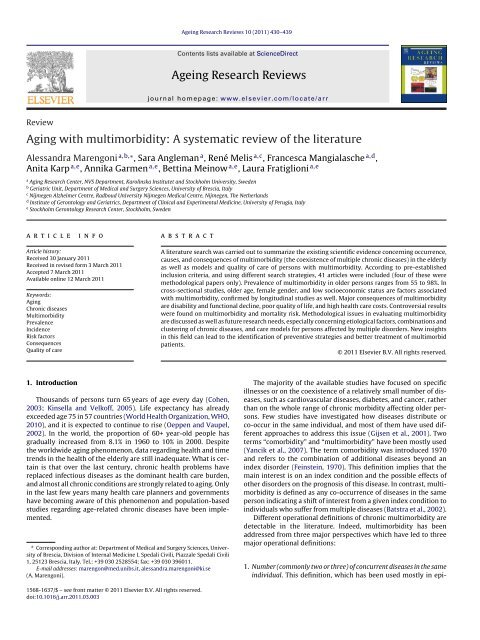

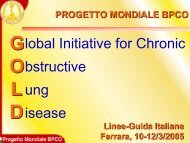
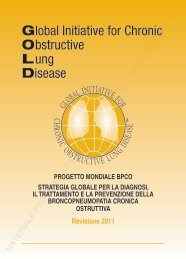
![Di Bari [NO].pdf - GOLD](https://img.yumpu.com/21544924/1/190x143/di-bari-nopdf-gold.jpg?quality=85)


